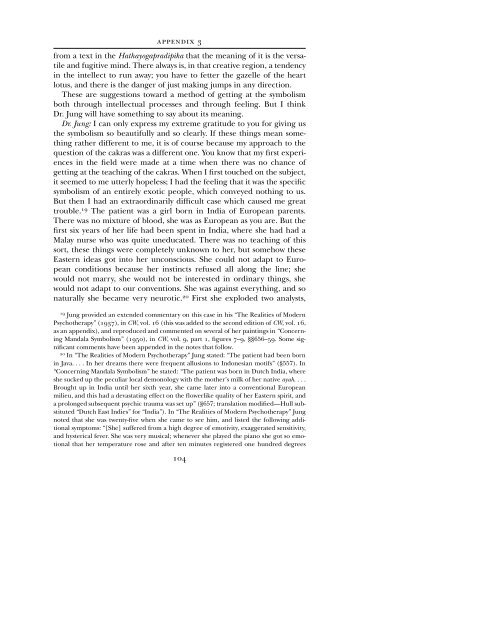CG JUNG - Countryside Anarchist
CG JUNG - Countryside Anarchist
CG JUNG - Countryside Anarchist
Create successful ePaper yourself
Turn your PDF publications into a flip-book with our unique Google optimized e-Paper software.
APPENDIX 3<br />
from a text in the Hathayogapradipika that the meaning of it is the versatile<br />
and fugitive mind. There always is, in that creative region, a tendency<br />
in the intellect to run away; you have to fetter the gazelle of the heart<br />
lotus, and there is the danger of just making jumps in any direction.<br />
These are suggestions toward a method of getting at the symbolism<br />
both through intellectual processes and through feeling. But I think<br />
Dr. Jung will have something to say about its meaning.<br />
Dr. Jung: I can only express my extreme gratitude to you for giving us<br />
the symbolism so beautifully and so clearly. If these things mean something<br />
rather different to me, it is of course because my approach to the<br />
question of the cakras was a different one. You know that my first experiences<br />
in the field were made at a time when there was no chance of<br />
getting at the teaching of the cakras. When I first touched on the subject,<br />
it seemed to me utterly hopeless; I had the feeling that it was the specific<br />
symbolism of an entirely exotic people, which conveyed nothing to us.<br />
But then I had an extraordinarily difficult case which caused me great<br />
trouble. 19 The patient was a girl born in India of European parents.<br />
There was no mixture of blood, she was as European as you are. But the<br />
first six years of her life had been spent in India, where she had had a<br />
Malay nurse who was quite uneducated. There was no teaching of this<br />
sort, these things were completely unknown to her, but somehow these<br />
Eastern ideas got into her unconscious. She could not adapt to European<br />
conditions because her instincts refused all along the line; she<br />
would not marry, she would not be interested in ordinary things, she<br />
would not adapt to our conventions. She was against everything, and so<br />
naturally she became very neurotic. 20 First she exploded two analysts,<br />
19 Jung provided an extended commentary on this case in his “The Realities of Modern<br />
Psychotherapy” (1937), in CW, vol. 16 (this was added to the second edition of CW, vol. 16,<br />
as an appendix), and reproduced and commented on several of her paintings in “Concerning<br />
Mandala Symbolism” (1950), in CW, vol. 9, part 1, figures 7–9, §§656–59. Some significant<br />
comments have been appended in the notes that follow.<br />
20 In “The Realities of Modern Psychotherapy” Jung stated: “The patient had been born<br />
in Java. . . . In her dreams there were frequent allusions to Indonesian motifs” (§557). In<br />
“Concerning Mandala Symbolism” he stated: “The patient was born in Dutch India, where<br />
she sucked up the peculiar local demonology with the mother’s milk of her native ayah. ...<br />
Brought up in India until her sixth year, she came later into a conventional European<br />
milieu, and this had a devastating effect on the flowerlike quality of her Eastern spirit, and<br />
a prolonged subsequent psychic trauma was set up” (§657; translation modified—Hull substituted<br />
“Dutch East Indies” for “India”). In “The Realities of Modern Psychotherapy” Jung<br />
noted that she was twenty-five when she came to see him, and listed the following additional<br />
symptoms: “[She] suffered from a high degree of emotivity, exaggerated sensitivity,<br />
and hysterical fever. She was very musical; whenever she played the piano she got so emotional<br />
that her temperature rose and after ten minutes registered one hundred degrees<br />
104


